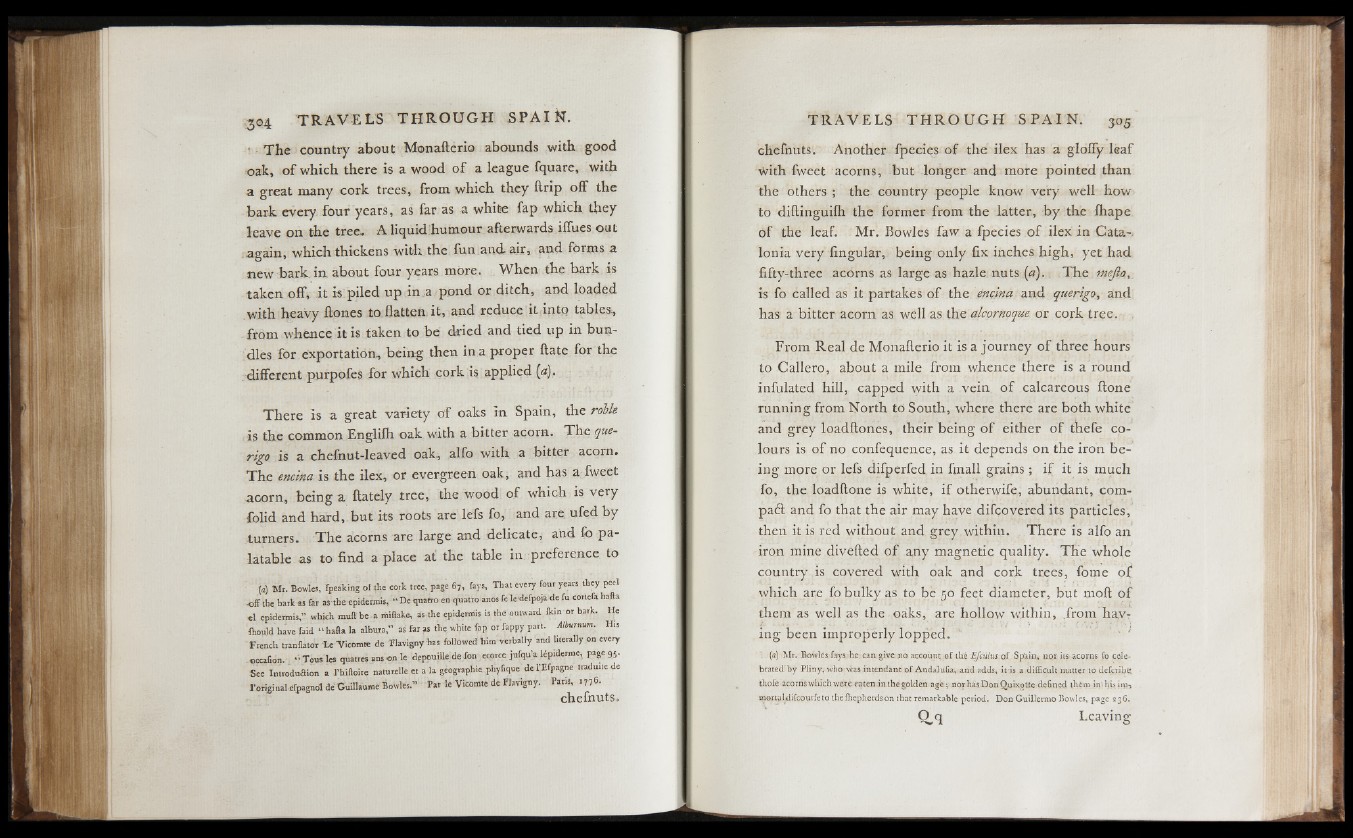
• The country about Monaiterio abounds with good
oak, o f which there is a wood o f a league fquare, with
a great many cork trees, from which they ftrip off the
bark every four years, as far as a white fap which they
leave on the tree. A liquid humour afterwards iffues out
again, which thickens with, the fun and. air, and forms a
new bark, in about four years more. When the bark is
taken off, it is piled up in a pond or ditch, and loaded
with heavy ftones to.flatten.it, and reduce it into tables,,
from whence it is taken to be dried and tied up in bundles
for exportation, being then in a proper ftate for the
different purpofes for which cork is applied (a).
There is a great variety of oaks in Spain, the robk
is the common Engliih oak with a bitter acorn. The que-
rigo is a chefnut-leaved oak, alfo with ,a bitter acorn.
The enema is the ilex, or evergreen oak, and has a fweet
acorn, being a ftately tree, the wood of which is very
folid and hard, but its roots are lefs fo, and are. ufed by
turners. The acorns are large and delicate, and fo palatable
as to find a place at the table in preference to
(a) M r. Bowles, fpeakmg of the cork tree, page 67, fays, Tha t every Four years they peel
o f f the bark as far as the epidermis, “ Dequarro en quatro anos fe led e fp ojad e fu cortefahafta
e l epidermis,” which mull be -a miflake, as the epidermis is the outward fkin or bark. He
dhould have faid “ hafla la albura,” as' far as the white fap or fappy part. Alburnum. His
French tranflator L e Vicomte de Flavigny has followed him’ verbally and literally on every
cccafion. . - T o u s les quatres ans o n le d é p o u i l l é d e f o n .ecorce jufqu'a lépiderme, page 95.
S e e Imrodu&ion a I’hiftoite naturelle et a la géographie phyf,que d e l ’Efpagne traduite de
3 ’ o r i g i u a l e f p a g u d l de Guillaume Bowles.” Par le Vicomte de Fiavigny. Paris, 1776.
chefnuts.
chefnuts. Another fpecies of the ilex has a gloffy leaf
With fweet acorns, but longer and more pointed than
the others ; the country people know very well how
to diftinguiih the former from the latter, by the ihape
o f the leaf. Mr. Bowles faw a fpecies o f ilex in Cata-.
Ionia very lingular, being only fix inches high, yet had
fifty-three acorns as large as hazle nuts (0). The mejlo.
is fo called as it partakes of the encina and querigo, and
has a bitter acorn as well as the alcornoque or cork tree.
From Real de Monailerio it is a journey of three hours
to Callero, about a mile from whence there is a round
infulated hill, capped with a vein o f calcareous ftone
running from North to South, where there are both white
and grey loadftones, their being of either of thefe colours
is of no confequence, as it depends on the iron being
more or lefs difperfed in fmall grains ; if it is much
fo, the loadftone is white, if otherwife, abundant, compatì
and fo that the air may have difcovered its particles,
then it is red without and grey within. There is alfo an
iron mine divefted o f any magnetic quality. The whole
country.is covered with oak and cork trees, fome of
which are fo bulky as to be 50 feet diameter, but moli o f
them as well as the oaks, are hollow within, from having
been improperly lopped. P
: (a)-Mr.- Bovvlés fays he can, give no. account of thè Efcùlus of Spain., nor its acorns fo celebrated.
by Pliny, who \$as intendant of AndaluGa,. and adds, it is a difficult inatter to defctib^
thofe acornswhjch were eaten in the golden age; nor has Don Qjuixotte defined them in> his irp-j
mortalilifcourfetó thè fliepherds on that remarkable period. Don Guillermo Bowles, page 236.
Q,q Leaving